#Igor Kordey
Explore tagged Tumblr posts
Text

Darth Vader by Igor Kordey
430 notes
·
View notes
Text


1996's What If...? Vol.1 #85 (What If…Magneto Ruled All Mutants ?) cover by cover artist Igor Kordey.
#Magneto#what if#1990s#Igor Kordey#Uncanny X-Men#What If…Magneto Ruled All Mutants ?#What If...?#max eisenhardt#erik lensherr#master of magnetism#x men comics#comics#marvel#marvel comics#cover#art#90s#90's#cool comic art#x men#ruler#mutant nation#mutants unite#mutants and proud#90s xmen#90s comics#alterniverse#Avalon#Acolytes#to me my x men
95 notes
·
View notes
Text


Artwork for Yugoslavian releases of Neuromancer and Burning Crhome in Sirius magazine. Art by Igor Kordey
109 notes
·
View notes
Text
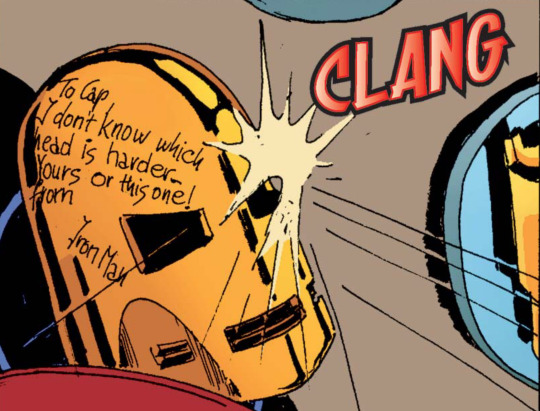
Captain America (1998) #50
#marvel#avengers#marveledit#comicedit#tonystarkedit#ironmanedit#captainamericaedit#steverogersedit#stony#tony stark#iron man#steve rogers#captain america#captain america (1998)#616#igor kordey#brian david-marshall#marvel comics#avengerscompoundedit
151 notes
·
View notes
Text
2025 Book Review #1 - 20th Century Men by Deniz Camp, S. Morian and Igor Kordey

There’s an issue left before the next Saga hardcover is complete. Which means that, to hold to my dizzyingly over-complicated set of reading goals for the year, I needed a different comic for January. Thankfully, one thing I never lack for is a long list of things being recommended to me. The basic pitch of this seemed interesting enough to try, and I’m happy I did. A bit unfocused and meandering for its limited run time, a bit didactic in its narration, but overall quite an interesting read.
The comic is set in a 20th century afflicted with heroism – the aging supersoldier who won WW2 for the United States is finishing his third term as President, a genius with an artificial heart and a hulking mechsuit is single-handedly holding the Soviet war effort in Afghanistan together, the culmination of a centuries-long eugenics and indoctrination program is spending his twilight years cleaning up all the British Empire’s messes and burning all the bodies before he turns off the lights – you get the idea. The war in Afghanistan – and the way it’s inching ever closer to World War 3 as the American Dream orders more and more open intervention against the Soviets – is the focus. The story is told from the perspective of American and Soviet soldiers, politicians and journalists, and the Afghan civilians and soldiers they’re ostensibly fighting for.
This is a comic that was created in the aftermath of the American withdrawal from Afghanistan and oh but you can tell. The human cost of wars of liberation and ‘nation-building’ and the sheer bloodlust involved in ‘peacekeeping’ and ‘counter-terrorism’ is a recurring theme throughout, both in Afghanistan and in flashbacks and discussion of Vietnam. The story does not have anything hugely original to say here, but it says it clearly and with some artistic flair.
More broadly the book is about – well, as the title says. It’s a comic with superheroes, but it’s not a superhero comic – the various heroes are all through-a-mirror-darkly takes on one classic cape or another, but the story isn’t at all interested in interpreting them according to the logic or history of superhero stories. They’re here instead as larger-than-life stand-ins and representations of this or that historical force. Captain America is a man obsessed with reclaiming the righteous moral purity of fighting the nazis and also a rough amalgamation of Nixon and Reagan. The Hulk is a walking war crime who caused such an embarrassingly public bloodbath in Vietnam that the government locked him in a black site until deciding his services are once again needed in Vietnam. Superman is the incarnate faith and belief of the Soviet people in the force of History and the coming communist paradise.
A faith and belief that, over the course of the story, vanishes or wastes away or (according to the narrator’s favourite theory) grew so disappointed with humanity that he killed himself. Which is the thesis of the story in a nutshell, really – the modernist, universalizing ideologies and narratives of the 20th century have, by the end of the ‘80s, grown threadbare and too worn out to take seriously. All that remains is old soldiers fighting a war they can’t conceive of ever winning, brutalizing everyone they claim to be here to uplift and save. Which they do with world-shattering skill and strength – destroying all the other dreams and alternatives which might have sprouted out around them almost as an after-thought. I say you can tell it was written in the 2020s, but honestly if you told me this was some particularly cynical Gen-Xer writing in the ‘90s or 2000s I’d believe you too. It’s all very End of History (but a bad thing).
Themes aside – as a work of visual art this comic is...not gorgeous exactly, but striking. Impressionistic and almost painterly, committed to conveying huge amounts in a panel or two and happily discarding any pretense of ‘realistic’ representation of the action to achieve it. The character designs often feel like caricatures or political cartoons, and I believe this is entirely intentional and even works. It, frankly, carries most of the book on its shoulders. Not that the writing isn’t good and even clever (I quite liked the issue where the narration was all quotations from news/history/propaganda texts with wildly different slants), but with basic/replacement-rate art this would barely be worth a second look.
In terms of plot and pacing the comic – well, mainly it acts like it has many, many more than six issues to make its point. Extended subplots that take up most of an issue end up going nowhere, characters get screen-time and development entirely out of proportion with how important to the plot they are, and when you really look at it the unifying story hanging it all together is surprisingly thin. Which isn’t a crippling issue in this case, really – it’s very much a theme-first sort of story, and each issue is mostly its own contained thing with its own narrative beats – but reading it as a single work you can definitely feel it. It also does feel like something of a bait and switch, as the first couple issues are by far the most plot-focused and afterwards it gets only more contemplative, impressionistic, and political.
In terms of politics – the last issue is in its entirety essentially a lecture and morality tale. One that feels a bit like having its cake and eating it too – it’s slightly rich to complain about Afghanistan’s role in the western imagination as a brutal, remote ‘graveyard of empires’ rather than somewhere people actually live when you’ve spent the first five issues of the comic leaning into precisely the same tropes. But still, I am a fairly easy sell for works on such daring and careful arguments as ‘invading Afghanistan was a bad idea’ (even if the story gives itself the easiest possible time making it).
Overall, I’m glad I read it. Worth a look if you like comics but wish Watchmen had come out last year.
22 notes
·
View notes
Text

Star Trek: The Gorn Crisis - USS Enterprise-E facing Gorn Fleet by Igor Kordey
#Star Trek#Comic#Comics#Wildstorm Comics#Star Trek: The Gorn Crisis#Gorn Hegemony#Federation#Starfleet#Sovereign Class#USS Enterprise-E#NCC-1701-E#Sci-Fi#Mecha#Spaceship#Igor Kordey
43 notes
·
View notes
Text

Freaks
Igor Kordey
17 notes
·
View notes
Text
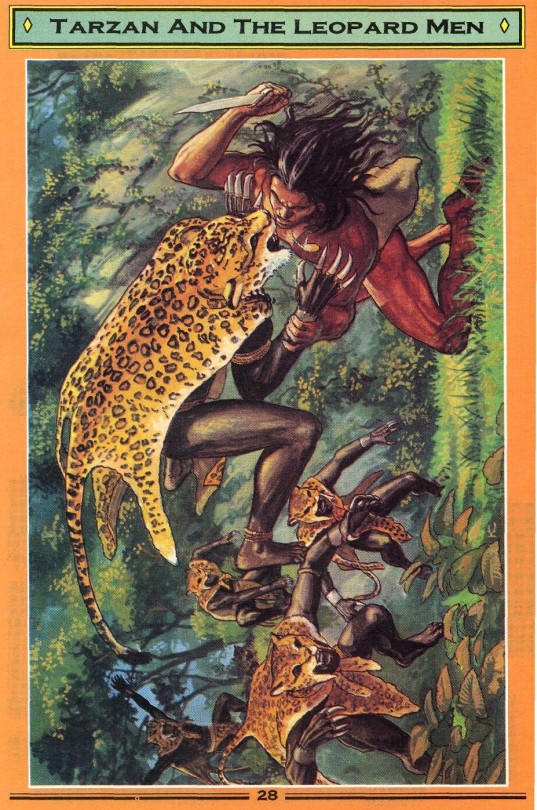

Tarzan by Igor Kordey
#tarzan#lord greystoke#igor kordey#malibu comics#modern age#edgar rice burroughs#john clayton#igor kordej
29 notes
·
View notes
Text
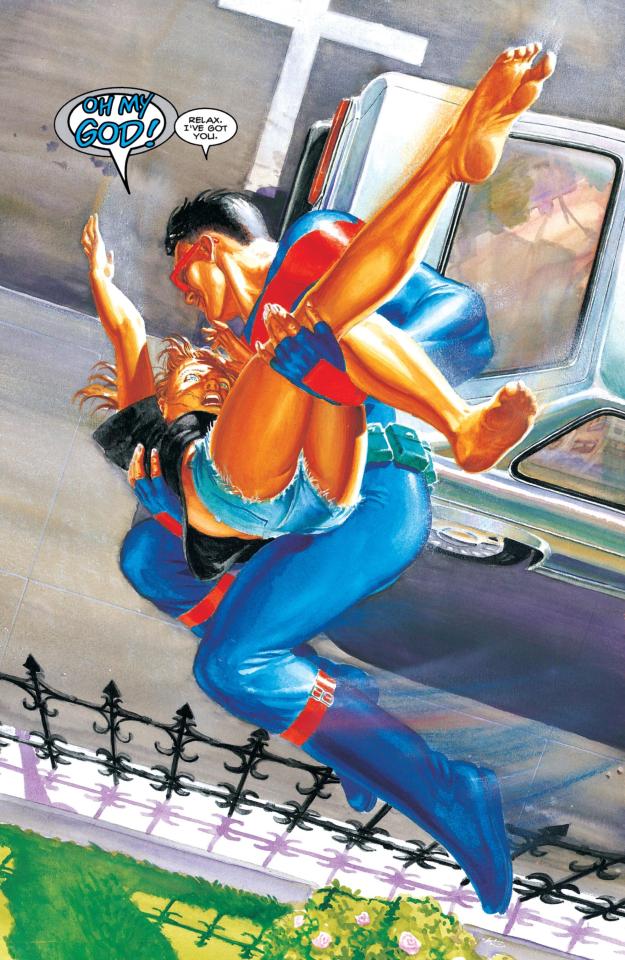
10 notes
·
View notes
Text

Marshal Bass
Cover by Igor Kordey
Ablaze
15 notes
·
View notes
Text





2001's Cable Vol.1 #100 cover by artist Igor Kordey. Source Source
#Cable#Igor Kordey#Nathan Summers#askani#askani son#marvel comics#art#soldier x#comics#marvel comic books#cool cover art#cool comic art#x men comics#00s comics#early 2000s#nathan dayspring#comic art#summers family#x men characters#x force#x men#2000s comics#00s#cool#cool look#cool design#comic books#cable comics#techno organic arm#early 00s
31 notes
·
View notes
Text
























Star Wars Chewbacca #1 of 4 -January 2000- Dark Horse Comics
written by Darko Macan
story pages 1-11 penciled by Brent Anderson
story pages 1-11 inked by Will Blyberg
story pages 1-11 colored by Nathan Eyring
story pages 12-22 illustrated by Igor Kordey
story pages 12-22 colored by Matthew Paine
lettered by Vickie Williams
cover art by Sean Phillips
#star wars#chewbacca#dark horse comics#darko macan#brent anderson#will blyberg#nathan eyring#igor kordey#matthew paine#vickie williams#sean phillips#comics#wookies
3 notes
·
View notes
Text
Cable - Igor Kordey Appreciation Post
Cable Vol. 1 No. 98 to 107 Released Sept. 2001 to July 2002

What RE-re-ignited my interest in early 2000s Marvel comics is a discussion on Twitter (X?) about whether Igor Kordey is a good artist.
In defense of the artist, @psychic_driving posted some of Kordey's Cable covers. They’re great. I was lucky enough to find almost all of them in a bargain bin a few weeks later. Turns out they are from the early 2000s, with the first issue releasing on September 19, 2001, according to the Marvel Database FANDOM site.
Kordey’s art inside the books has its pros and cons. But it’s hard to imagine anyone having anything bad to say about this run of covers. I’m on the side that stylish is always better than “realism.” One of the reasons superhero comics are so fantastic is how they collect decades worth of different interpretations of characters and imagery. One of the reasons so many superhero comics on the shelves today are so bland and unappetizing is the “basic” art (and especially the completely thoughtless panel/page compositions). Respect to the artists who are likely working under tight deadlines for not enough pay, but most books on the shelf can't hold a candle to competition like Tradd Moore’s recent Doctor Strange mini-series, Fall Sunrise.
Marvel’s 9/11 memorial ribbon also began appearing on Cable covers for the first time during Kordey’s run, on issue 99, which was released on November 14, 2001.

The versions of the covers that Marvel has online today don’t include the memorial ribbon, but the original floppies had it at least until Marvel stopped publishing Cable Volume 1 altogether with issue 107 (released July 2002). (It looks like Cable transformed into a new series, Soldier X, keeping Kordey on art for a while but introducing a new writer. Kordey’s covers on Soldier X also stand out, but have a painterly quality that diverges from the pop graphic style stunners of the Cable covers.)
More on how the pages of Cable responded to 9/11 soon. For now, enjoy the art.
Thanks to my local comics shops Capital Comics in Raleigh, NC and Ultimate Comics in Cary, NC for being great stores where I was able to find these back issues.





Images via Marvel Database and eBay.
32 notes
·
View notes
Text

Grant Morrison, Frank Quitely et al: New X-Men Modern Era Epic Collection: E is for Extinction (2001-2002)
#grant morrison#frank quitely#new x men#x men comics#epic collection#marvel#comics#2000s#igor kordey
3 notes
·
View notes
Text

Tarzan by Igor Kordey
#Igor Kordey#Tarzan#tarzan of the apes#edgar rice burroughs#lord of the jungle#art#male character#portrait
4 notes
·
View notes
Text
Apparently Mystique in the comics was once given Rebecca Romijn's design from the live-action X-Men movies for only two issues...
While Marvel & DC Comics often try to emulate their respective live-action movie counterparts by making alterations to certain character's designs, powers and even personalities (such as Spidey briefly adopting organic webbing to reflect the Sam Rami Spider-Man trilogy, or Iron Man becoming more snarky and jokey to reflect Robert Downey Jr.'s performance in the MCU), sometimes said-alterations either end up not working or even lasting long...
Case in point to the latter... back in the early 2000s Marvel actually tried to have Mystique (aka, Raven Darkholme) in the X-Men comics emulate actress Rebecca Romijn's physical portrayal of the character from the live-action X-Men movies, but it quite literally only stuck around for just a single issue! Specifically in X-Men: Forever (2000) #6 by Fabian Nicieza & Kevin Maguire, both Mystique & Toad were exposed to some kind of radiation device while teaming-up with various X-Men members, and in the process had both their mutant powers and physical appearances significantly altered to more heavily resemble their live-action counter-parts. Toad was given his elongated tongue (which he originally lacked during the Silver Age and solely had the leaping abilities), whereas Mystique was obviously given her naked scaly reptilian appearance from the movies as her new "default" form.
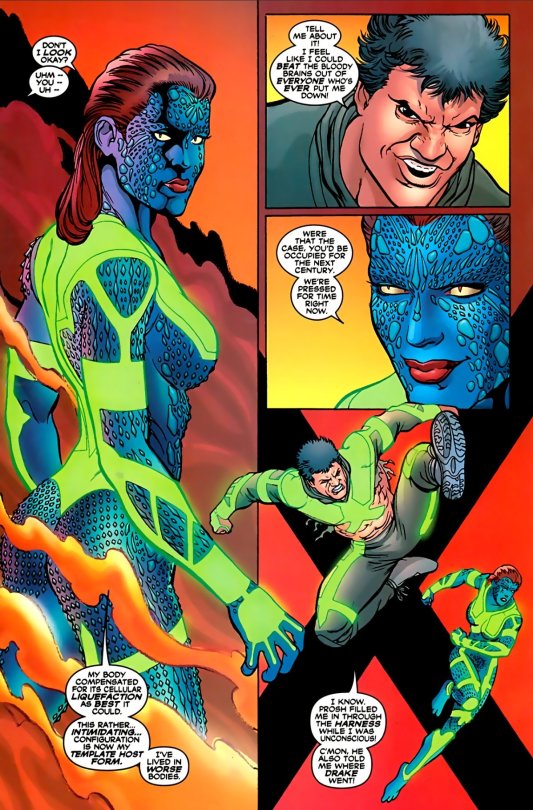
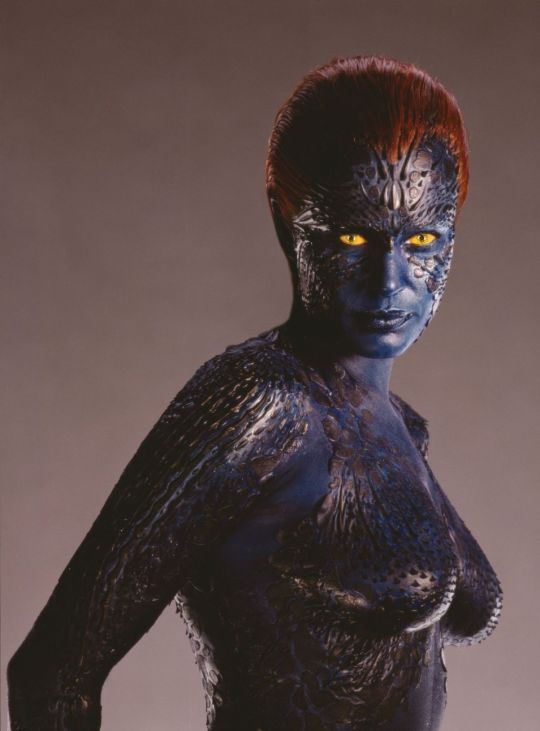
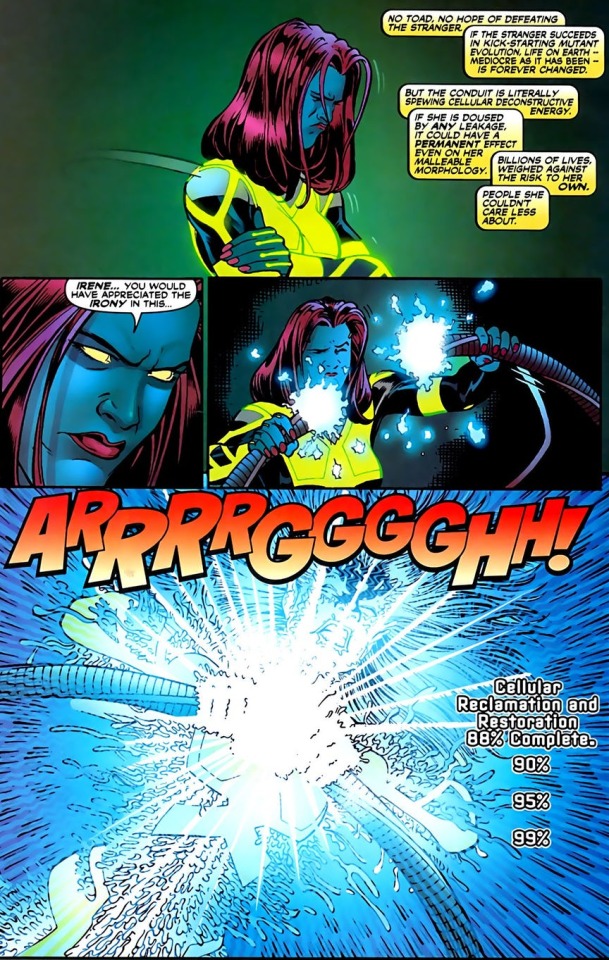
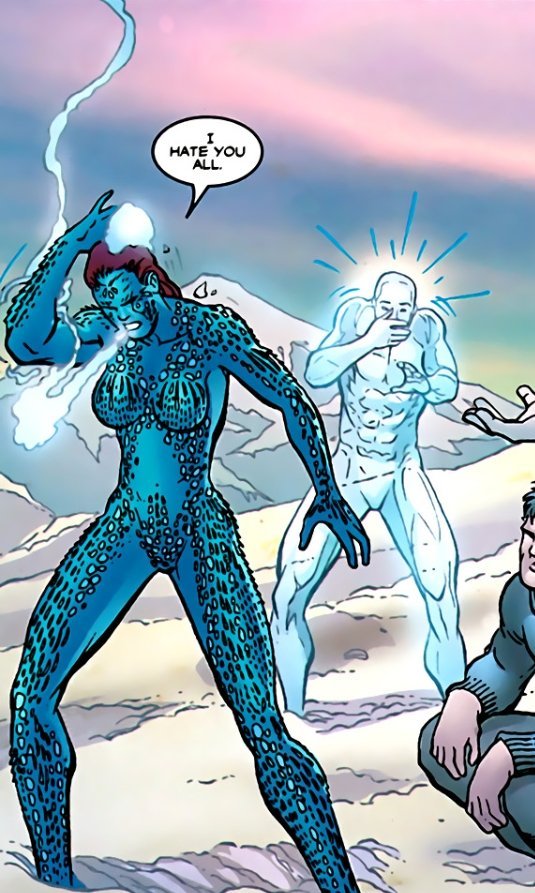
This issue came out in April 2001.
However a little over one-year-later in July 2002 when Mystique appeared in Uncanny X-Men (1963) #405 by Joe Casey & Sean Phillips, Mystique was suddenly back in her normal comic book appearance without any explanation. In fact, the only other time the scaly-reptilian design reappeared in comics was in a nightmare sequence from X-Treme X-Men (2001) #33 by Chris Claremont & Igor Kordey from October 2003, wherein a villain named the Reverent caused Rogue to suffer a vision wherein she transforming into her adoptive mother in both appearance and personality and sadistically slaughtering her fellow-teammates Bishop, Storm & Gambit.
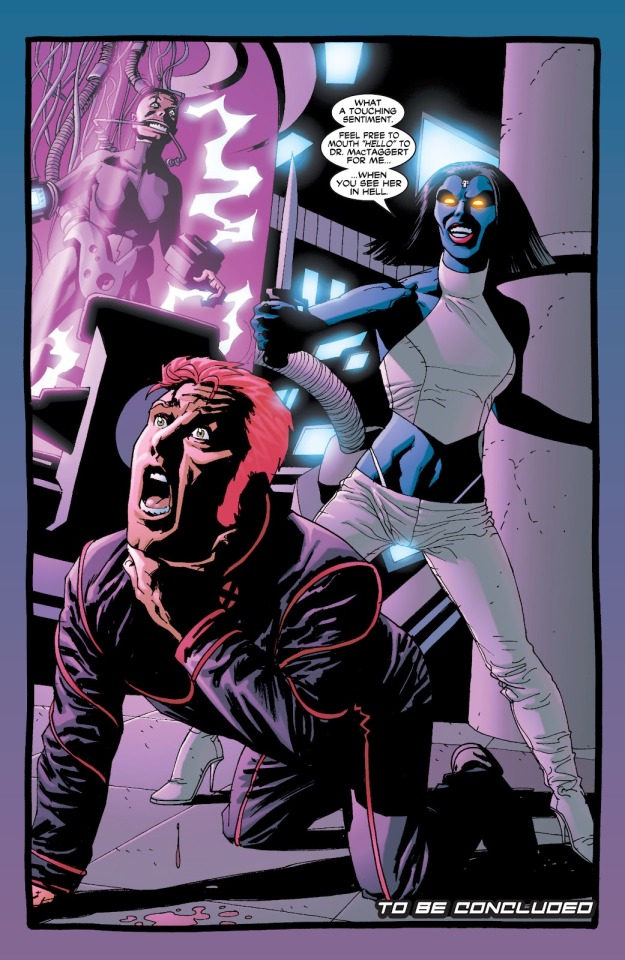


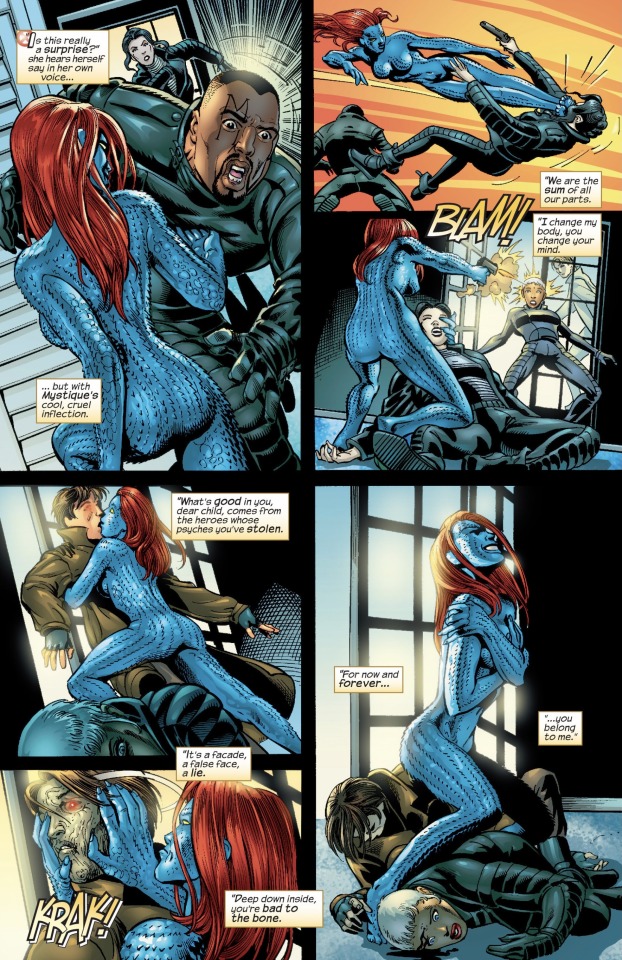
Aside from those two examples, Marvel has never had Mystique in the comics adopt her design from the live-action X-Men movies.
Heck, the only other time Marvel tried to have Mystique emulate Rebecca Romijn's portrayal was in Wolverine #64 & #65 from 2008 as the finale to Jason Aaron & Ron Garney's awesome "Get Mystique" storyline, when in preparation for her final confrontation with Wolverine in the story's climax, Mystique utilized her shapeshifting powers to erase her clothing, fighting Logan completely naked in order to demonstrate to him that she's not a coward nor is she ashamed of herself. And even then, this time Raven lacked the reptilian-scales of her live-action movie counterpart, instead maintaining to her classic comic book design just without the white dress or skull adornments.




But yeah... just a weird bit of obscure trivia concerning Marvel's iconic shapeshifting femme fatale.
I wonder why Marvel suddenly ditched the live-action movie design after only introducing it for a single issue and describing it as her new "default form." I know there was a year in-between the publishing of X-Men Forever #6 and Uncanny X-Men #405, but still...
#mystique#raven darkholme#rebecca romijn#x men movies#x-men forever#uncanny x-men#x treme x men#wolverine#fabian nicieza#kevin maguire#joe casey#sean phillips#chris claremont#igor kordey#jason aaron#ron garney#toad#mortimer toynbee#rogue#anna marie lebeau#bishop#gambit#remy lebeau#storm#ororo munroe#james logan howlett#get mystique#triva#marvel comics#graphic content
29 notes
·
View notes